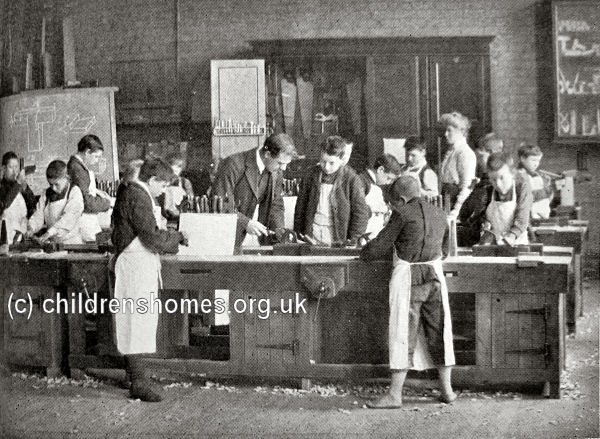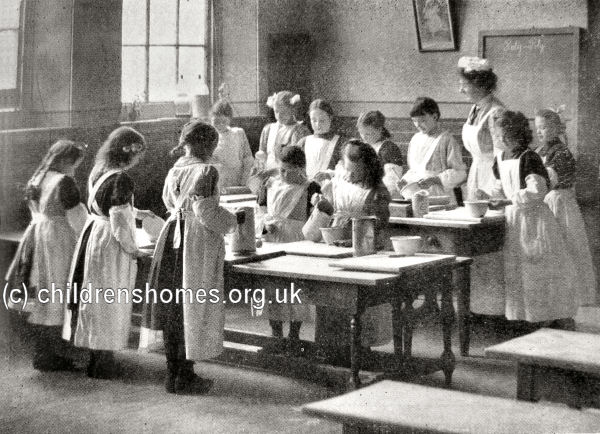Edinburgh School Board Day Industrial School, Edinburgh, Edinburgh, Scotland
In 1898, the Edinburgh School Board Day opened a Day Industrial School at the north side of St John's Hill, Edinburgh. It was the first such institution in Scotland under the management of a School Board was established largely through the efforst of Miss Stevenson, a long-serving member of the Edinburgh Board.The school's premises were formally certified for use on 18 July 1898, with accommodation for up to 160 children aged 5-14 at their date of admission. Magistrates could place children at the school whose education was neglected by their parents, or who were found wandering or in bad company.
An inspection report in 1899 noted that the building was a plain, substantial and handsome structure. Its main defect was its small scullery which needed to be enlarged. The installation of a copper in the kitchen was also advised, large enough to provided tea, coffee etc. for all the children in one operation. The superintendent and head teacher at that date was Miss L Clark, assisted by Miss A Coyle, Miss SC Taylor, a kitchen matron and a janitor. The following year it was noted that the children's singing, recitation and geography were all 'good', object lessons had been given to the whole school, and that history and drawing were also being taught. Industrial training for the boys included manual instruction (woodwork) and mat-making. The girls had lessons in sewing and knitting and took it in turns to help in the kitchen. There was regular musical drill with wands and dumb-bells.

Edinburgh Day Industrial School carpentry class, c.1908. © Peter Higginbotham

Edinburgh Day Industrial School cookery class, c.1908. © Peter Higginbotham
Miss Clark left the school in August 1907 and was succeeded by Miss Jean J. Reith. An inspection report that year noted that a visiting instructor took free and applied gymnastics once a week. The annual trip to Polton had taken place in June, and a soirée and cinematograph entertainment was given in the winter. A savings bank had been begun and was proving popular. A system of money awards had been instituted, the amount to the credit of each child being banked against the time of the child leaving the school.
Below is part of an interesting description of the school from 1914.
The Day Industrial School at St John's Hill is an institution which dates back to 1898. Hundreds of boys and girls have passed under its civilising influence, and there are to-day in the school 120 boys and 34 girls. It is the only school of its kind in Edinburgh; but there are seven in Glasgow. The institution must be regarded as a social necessity. For instance, it is the place where poor children, whose widowed mothers may be at work all day, may put in a twelve hours' stretch, get three meals day, sound elementary education, and knowledge of useful work, and be always in safe hands. Many of the children otherwise received are the victims of neglect, and are underclad and underfed. They rapidly respond to reasonably humane conditions. They are bairns who up to the time of arriving at St John's Hill have never had a real chance in life; but when they get it they take it.
Under the warrant of the magistrates in the Burgh Court come children who have been truants, who are "beyond the control" of their parents. To see some the tiny tots who have outraged the parental laws is simply grotesque, and one is disposed to believe that the parents are quite pleased to see little Tommy or Annie off their hands, at the cost of one shilling per week, paid to the school. Truancy is here rapidly — almost instantaneously — cured. On the day of the writer's visit there was only one boy absent on a doctor's line. Only in two or three cases are children brought to the school by parents, and though some of the pupils are extremely young, they soon learn to come themselves. According to regulations, the school door is kept locked; but nothing would be easier for active youngsters to take 'French leave." They never think of it. They go all over the city on messages, and return without hesitation. Firmness is necessary in a school which is largely recruited from the "failures" of other schools; but trust in the children is appreciated by the young folk, who in time of test will not let their teachers down. In an industrial school there is in reserve the rod of punishment, and it must be there. Rarely is its use required at St John's Hill, and when the offender is dealt with there no trace of sulkiness and ill will. The punishment is earned and accepted.
At a time like this most of the children are barefoot It is rather curious to see the boy joiners standing at their bench bootless and stockingless. The clothes question at John's Hill is very serious one. Miss Reith, the lady superintendent, could do with a much greater supply of garments than she receives from the outside public. How necessary they are may be shown in the case of girls who leave the school for domestic service. Owing to mothers appreciating weekly wages, very few girls are able to take the wise step of going into service; but when they do, their outfit has always to be provided at the school. Many of the children are sufficiently clothed, but are not always warmly clothed. The sanitary standard of the school is high. There is medical inspection and the supervision of a nurse. If at the weekly bath any of the children's clothing is in a dirty state, the reason is investigated at once. This examination keeps the mothers or guardians up to the mark.
Children come to the school from all parts of the city — from Gorgie along to the boundary of Leith. The older parts of Edinburgh, however, provide most of the pupils. Some of the young folks come from wretched homes: but if tings are really hopeless, the authorities fall back on the industrial schools at Liberton, Gilmerton and Tranent. The institution t St John's Hill is undenominational in respect that Protestant and Catholic children are received, and special arrangements are made for the religious instruction of Catholics by a teacher of their own creed. The school opens at six o'clock in the morning, and all the children must be in by eight o'clock. They remain until six o'clock. The school work is varied in several ways, but the actual time in the strictly educational course is not longer than in Board schools.
The children invariably when they enter the school are not enthusiastic over the provender provided. They have been reared on tea and scraps, and they do not at first appreciate the old-time Scottish staples — broth and porridge. Their internal economy is not fitted for them. Gradually, the healthier taste is stimulated, and the effect of good, well-cooked diet is apparent on the physique of the child, many of whom are at entry puny and under-sized. Their growth is even slow under the care of the staff; but the majority of the older children are in excellent condition. One or two of the younger children on a warm summer afternoon in the classroom seemed as if they would be better for "forty winks." As one sees these children together, the regret is that any of them should be outside their home for so long as they are: but too many examples of the need of the school are offered to express any doubt as to the need for its existence.
The school was formally closed as of 12 April 1921. The building no longer survives.
Records
Note: many repositories impose a closure period of up to 100 years for records identifying individuals. Before travelling a long distance, always check that the records you want to consult will be available.
- Edinburgh City Archives, Level 1, City Chambers, 253 High Street, Edinburgh EH1 1YJ, Scotland. Has School log-book (1896-1921).
Bibliography
- Higginbotham, Peter Children's Homes: A History of Institutional Care for Britain s Young (2017, Pen & Sword)
Links
- None identified at present.
Except where indicated, this page () © Peter Higginbotham. Contents may not be reproduced without permission.


